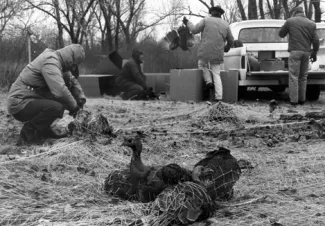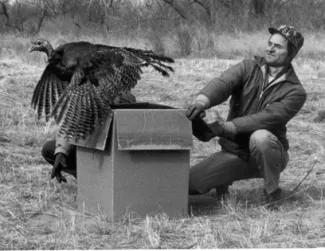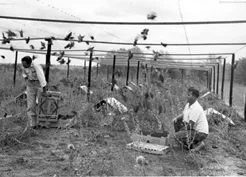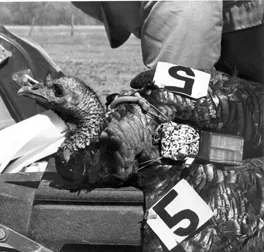History tells of early Americans and their westward expansion along the nation’s waterways – pioneers venturing out into an endless sea of grass, clinging to the rivers as lifelines for water and shelter. Game was plentiful near these arteries in the prairie. Riverside trees were often the only available roost sites for wild turkeys, and as such, the bird that Ben Franklin sought to make our national symbol was destined to cross paths with incoming settlers, and become a part of Oklahoma history.
Among the first records of Oklahoma turkeys are the writing of Washington Irving, who, in 1832, described abundant turkey populations near what is now Oklahoma City and Norman. Naturalist Samuel Woodhouse traversed the northern tier of the state in 1849, and complained in his journal of eating wild turkey at every meal. Later, General Philip Sheridan reported a North Canadian River turkey roost that was more than three miles long.
But like all game species, turkey populations can only handle certain amounts of pressure. The Land Run of 1889 turned the trickle of incoming settlers into a flood, and they brought with them ever-increasing subsistence hunting and demand for timber, which they met by cutting many of the trees that lined the riverbanks. By 1925 wild turkeys were so rare in Oklahoma that most people thought they were extinct.
In 1948, the Oklahoma Department of Wildlife Conservation embarked on a stocking program to reestablish the wildreleasing wild turkey from a box turkey to its former range. It was an ambitious proposal to say the least. Biologists discovered that even where suitable habitat remained, the birds were totally absent from the central and western portions of the state, and numbers were probably less than 1,000.
But when 21 Rio Grande turkeys were captured in the Texas panhandle and relocated to Harper County, the foundation was laid for one of our greatest wildlife management success stories.

The Harper County flock grew quickly thanks to protection by Department game wardens, allowing biologists to trap and transplant surplus birds to other suitable habitats. By 1960, just 12 years after the effort began, Oklahoma established a fall hunting season. The first spring season followed just a few years later.
As successful as the Rio Grandes were in their new range, eastern Oklahoma was still nearly devoid of turkeys. According to reports, the last wild flock of Eastern birds disappeared from Latimer County in 1956. By 1963, the Department restocked the east with pen-raised birds that proved ineffective for viable, self-sustaining populations. Although approximately 5,000 turkeys were raised and released in the wild, no more than 150 could be found seven years later.

It was during this time that biologists began to learn a great deal about turkeys by studying the flourishing western populations as well as the handful of Eastern birds, which successfully adapted to their wild environments. Details about their natural history such as food preferences and life cycles were documented. Today, biologists are still adding information to this database, enabling them to understand even more about these birds.
Because of obvious differences in the two subspecies, turkey managers decided the best route for the reintroduction of Eastern turkeys would be a trap and transplant operation of birds from Arkansas and Missouri. A trade agreement was reached with these neighbor states and a number of Eastern wild turkeys were swapped for some walleye fry and prairie chickens.

In 1971, eight tom and 10 hens were released in LeFlore County’s Ouachita Mountains. Later, more birds were released in the Spavinaw Hills in Delaware County. A successful hatch was recorded the first year and the Eastern subspecies had stared up the comeback trail. Within a few years, more turkeys were released at game management areas at Atoka, Robbers Cave, Cookson Hills, McCurtain County Wilderness Area, and Pushmataha County. In 1975, 59 years after Oklahoma closed the season on wild turkeys, the Department reopened a spring gobbler hunt in LeFlore and part of McCurtain Counties.
Today, huntable populations exist in all 77 counties.

Radio transmitters keep the research biologists informed on turkey movements during home range and life history studies.